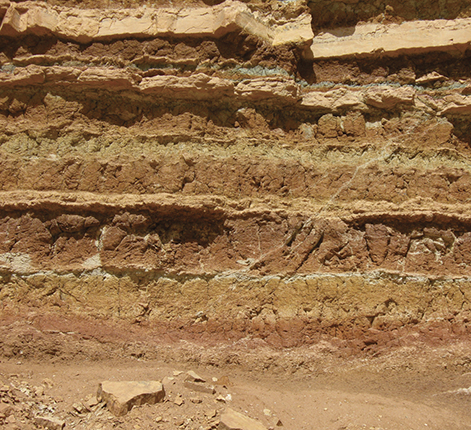Mysteries from the annals of geology
DOI: 10.1063/PT.3.3924
Donald Prothero’s The Story of the Earth in 25 Rocks: Tales of Important Geological Puzzles and the People Who Solved Them explains how we know what we know about Earth’s past and present. The book presents tales of perplexing observations, the detective work that led to important insights, and the people who made those insights happen.

Geological strata in Negev, Israel.
ADAM MATAN

With his background in geology and paleontology, Prothero understands the science and has a knack for distilling it into captivating and accurate prose. He clearly explains why the observations were confounding and why the questions they raised were important.

The Story of the Earth in 25 Rocks describes how geologists deciphered such riddles as the origins of volcanoes, earthquakes, and the Moon and came to embrace such new concepts as geologic time. Prothero includes the requisite death-of-the-dinosaurs chapter, but he also tells less well-known and equally compelling stories, such as “snowball Earth.” In fact, almost every subject covered in introductory geoscience classes is addressed through these stories. But the book is livelier and more engrossing than introductory textbooks. The chapters titled “Lodestones” and “Blueschists,” for example, are about the discovery of plate tectonics and the host of observations that the new theory could explain. “Glacial Erratics” (large boulders found in odd places) is the story of ice ages and their origins.
Some of the tales capture the huge and systematic effort that led to our current understanding of Earth’s physical history; for example, “Lodestones” includes an explanation of how geologists established the history of Earth’s magnetic field. Those narratives also serve as a reminder of the role of serendipity in scientific discoveries, and they illustrate how specific events, such as meteorite falls and the 1906 San Francisco earthquake, can lead to scientific breakthroughs. Furthermore, Prothero’s book emphasizes the interdisciplinary nature of the geosciences and how advances in understanding Earth draw on field observations, chemistry, physics, and biology.
Prothero makes a point of highlighting people whose contributions are sometimes overlooked, and he shows how new ideas often emerged from collective efforts. The American geologist Marie Tharp, for example, made maps of the seafloor that contributed to the discovery of seafloor spreading. Another example is Scottish geologist James Croll who, early in his career, was employed as a janitor. Croll was the first to propose that ice ages were caused by what we now know as Milankovitch cycles—that is, variations in Earth’s orbit around the Sun.
This is an engaging and readable book. Introductory quotations start each chapter with a bang. The chapter on volcanic tuff opens with Friedrich Nietzsche’s “Live in danger. Build your cities on the slopes of Vesuvius.” The chapter titles are curiously mundane, but their subtitles summarize in a phrase the significance of what is to come—“Early oceans and life? Evidence in a grain of sand,” for example, for the chapter “Zircons.” Readers interested in original sources and key papers, however, will need to do their own homework. The text does not include references, though chapters end with short lists of “further reading,” all of which are books.
Despite teaching the material covered in this book for more than a couple of decades, I learned something and gained a deeper appreciation for the history of Earth science from reading The Story of the Earth in 25 Rocks. I recommend it to anyone interested in tales of scientific discovery and natural marvels.
More about the Authors
Michael Manga is a professor of Earth and planetary science at the University of California, Berkeley. He studies volcanoes, geysers, the internal structure of Earth and other rocky planets, and earthquakes’ effect on fluids inside the crust. He has taught introductory Earth science courses for more than two decades.
Michael Manga. University of California, Berkeley.
